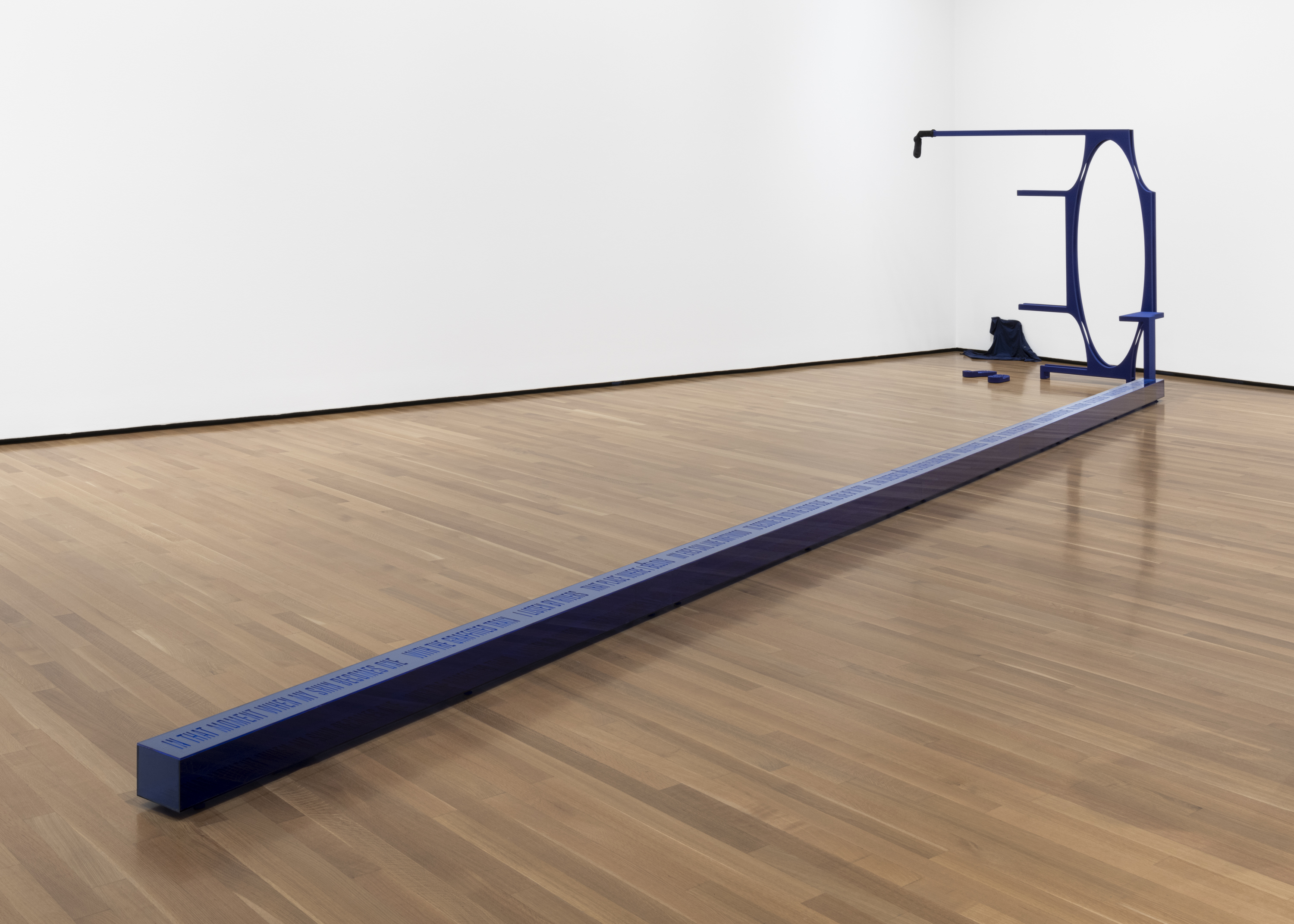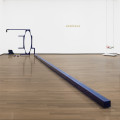Paul O'Keeffe
(Dublin, Ireland, 1957 - )
In Memoriam (In That Moment)
2022
Steel, Plexiglas, UltraCal plaster, medium-density fibreboard, fabric, and Flashe paint
90 x 78 x 414 in. (228.6 x 198.1 x 1051.6 cm)
Collection of the Akron Art Museum
Gift of the artist in memory of Christian O’Keeffe
2022.14
More Information
In Memoriam (In That Moment) consists of two primary elements. First, a low, straight line of blue Plexiglas extends about thirty feet across the floor, inscribed on its upward-facing side with a line of text. Second, at the end of the line where the text reaches its completion, stands an upright sculpture coated in densely pigmented Flashe paint that makes it especially deep and rich in blue color. The upright portion is adorned with a single sock and accompanied on the floor nearby by two boot print silhouettes as well as a t-shirt, all of them blue as well. These objects in themselves constitute an intriguing work of art. As viewers read the text from end to end, they are encouraged to walk the length of the sculpture and slowly experience its particularities. Precise edges and durable materials indicate concentrated intention, overall blue color unifies disparate forms and materials, and permeating unfamiliar strangeness lends an air of mystery. All of this is to say that In Memoriam (In That Moment) succeeds as sculpture even without its powerful backstory. Nevertheless, context enriches the work immeasurably, without dispelling its subtle and enigmatic qualities. Paul O’Keeffe created the sculpture in remembrance of his son Christian, who died by suicide in May of 2012. The work is meant to evoke the circumstances of his death as he was struck by a train on tracks along the Cuyahoga River near Kent. Christian was an aspiring poet studying at Kent State University, and the words on the long blue Plexiglas line are borrowed from a poem in which he imagined what O’Keeffe describes as anticipation of the “heightened, almost exhilarated state, how his body is going to fuse with a freight train.” The long line thus suggests the rail of the train tracks, while the overall blue color suggests both the Cuyahoga River below and the sky above. In walking the length of the sculpture and reading Christian’s words, viewers put themselves in the place of O’Keeffe’s late son. The artist sees the upright portion at the end of the work as akin to a mirror that marks a point of transition or departure, and it might also be interpreted as a portal or other form of opening, or perhaps as part of the train. The other items suggest both the presence and absence of Christian—the boot prints match his size thirteen. O’Keeffe has responded to his son’s death through artwork since at least 2017, when he showed five related works at The Sculpture Center in Cleveland in an exhibition titled Screaming Voicelessly to a Distant Silence. Though he would have continued in this vein regardless, the invitation to participate in the 2022 FRONT Triennial gave O’Keeffe an occasion to produce additional work, and he responded with six new sculptures shown at Transformer Station in Cleveland, the Cleveland Public Library, and the Akron Art Museum. At AAM, In Memoriam (In That Moment) was prominently featured in a larger group exhibition that responded to the 2022 edition of FRONT’s general theme of art’s potential for healing, encapsulated in the title Oh, Gods of Dust and Rainbows (a phrase drawn from a Langston Hughes imploring readers “to see That without the dust the rainbow Would not be”). Most of the works in both sets are painted blue, and the newer group is also drawn together by the common title In Memoriam, followed with each work by a different parenthetical phrase. The works also consistently feature text drawn from Christian’s writing and references to objects from his life. In keeping with the theme of the 2022 FRONT Triennial, O’Keefe’s In Memoriam sculptures provide potential for healing, or at least the processing of traumatic events. In the artist’s own words, after his son’s death “I was in a state of shock… I found a strange solace in starting to read my son’s poetry, in the sense that the years before his death, he had pulled away and wanted to be independent.” At the same time, the creation of artwork has not offered total solace, or even unambiguous progress: “I don’t know that it helps me process… It lets me ruminate in a way, which may not be entirely healthy.” Nevertheless, O’Keeffe describes himself as “very happy to have been able to make these pieces… I’m hoping—I don’t know if it’s possible to get closure from making a body of work or not—but I have moved on from thinking about it in a fairly obsessive way.” In Memoriam (In That Moment) likely does not suggest closure in itself, but as such it may stand as an apt and deeply sensitive response to an event of intense personal emotion.






